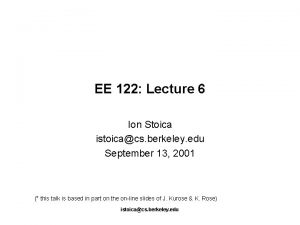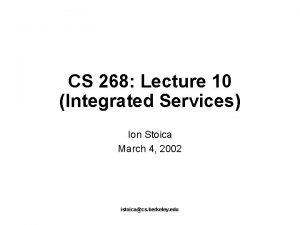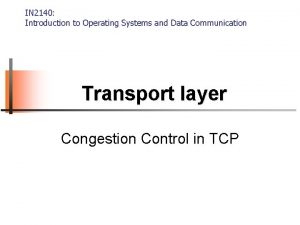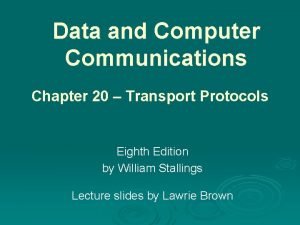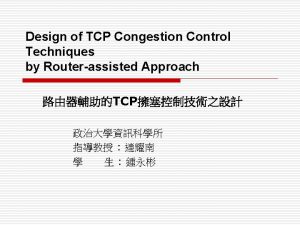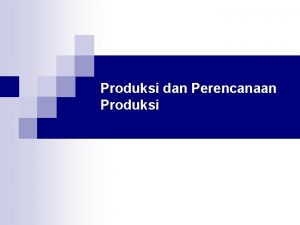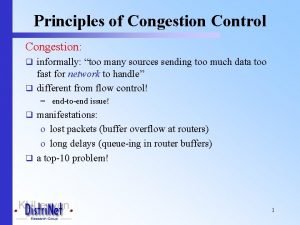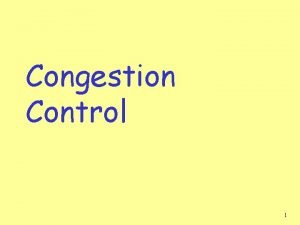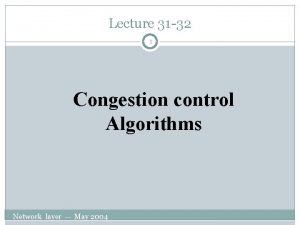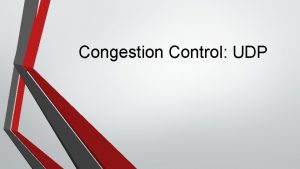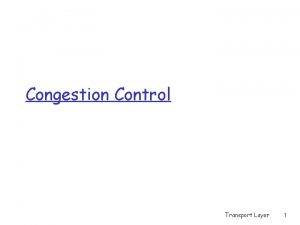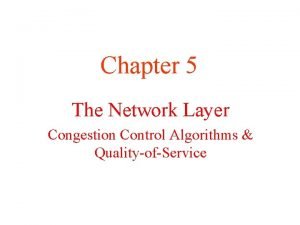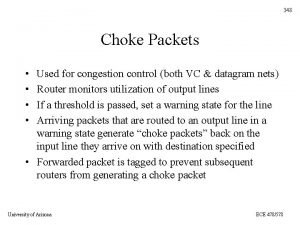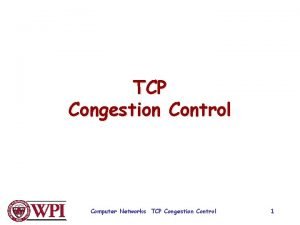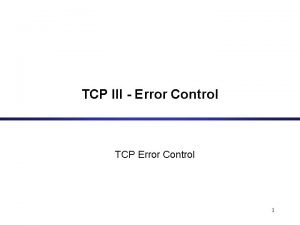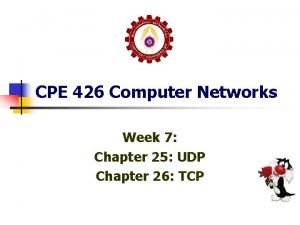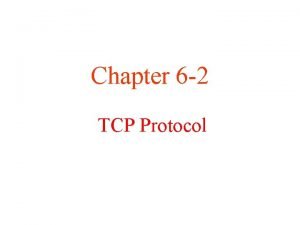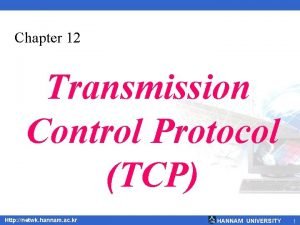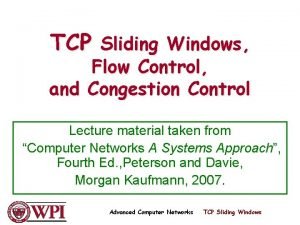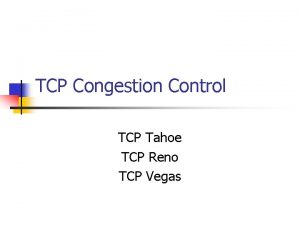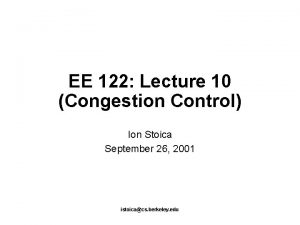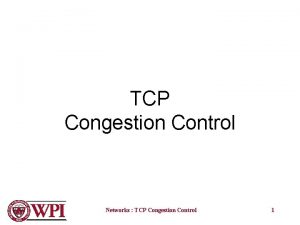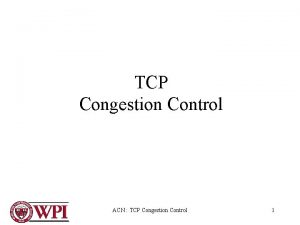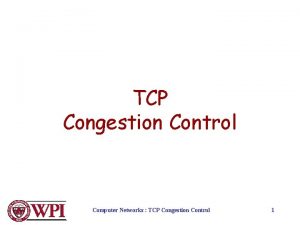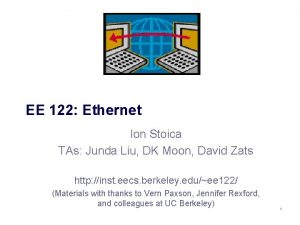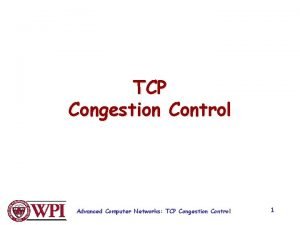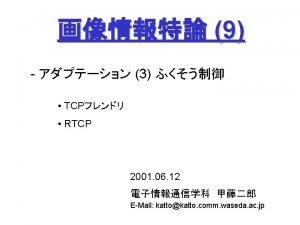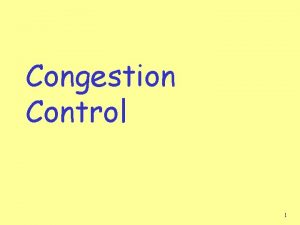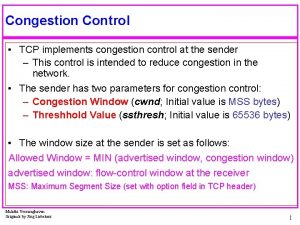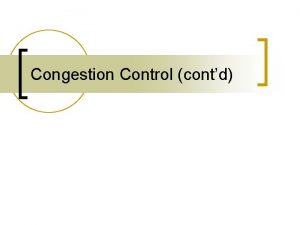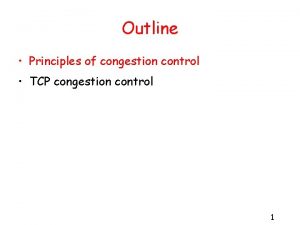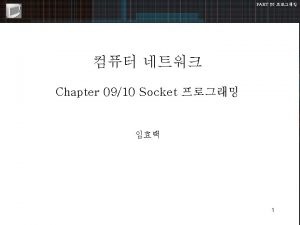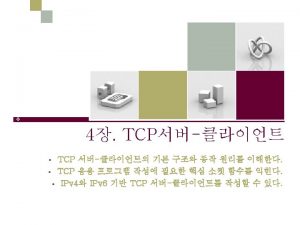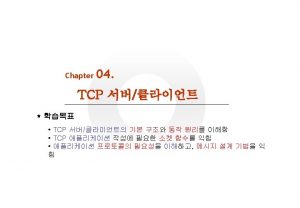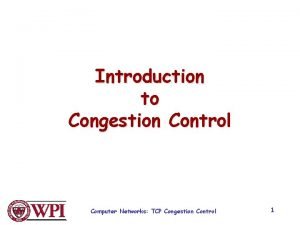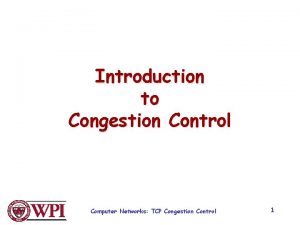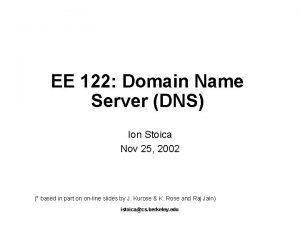EE 122 TCP Congestion Control Ion Stoica TAs


































- Slides: 34

EE 122: TCP Congestion Control Ion Stoica TAs: Junda Liu, DK Moon, David Zats http: //inst. eecs. berkeley. edu/~ee 122/ (Materials with thanks to Vern Paxson, Jennifer Rexford, and colleagues at UC Berkeley) 1

Goals of Today’s Lecture l Principles of congestion control l Learning that congestion is occurring Adapting to alleviate the congestion TCP congestion control l l Additive-increase, multiplicative-decrease (AIMD) How to begin transmitting: Slow Start 2

What We Know We know: l How to process packets in a switch l How to route packets in the network l How to send packets reliably We don’t know: l How fast to send 3

It’s Not Just The Sender & Receiver l l l Flow control keeps one fast sender from overwhelming a slow receiver Congestion control keeps a set of senders from overloading the network Three congestion control problems: l Adjusting to bottleneck bandwidth l l Without any a priori knowledge Could be a Gbps link; could be a modem Adjusting to variations in bandwidth Sharing bandwidth between flows 4

Congestion is Unavoidable l Two packets arrive at the same time l l l The node can only transmit one … and either buffers or drops the other If many packets arrive in a short period of time l l The node cannot keep up with the arriving traffic … and the buffer may eventually overflow 5

Congestion Collapse l l l Definition: Increase in network load results in a decrease of useful work done Due to: l Undelivered packets l Packets consume resources and are dropped later in network l Spurious retransmissions of packets still in flight l Unnecessary retransmissions lead to more load! l Pouring gasoline on a fire Mid-1980 s: Internet grinds to a halt l Until Jacobson/Karels (Berkeley!) devise TCP congestion control 6

Knee – point after which l l l Throughput increases very slowly Delay increases quickly Cliff – point after which l l Throughput starts to decrease very fast to zero (congestion collapse) Delay approaches infinity Delay l Throughput View from a Single Flow knee packet loss cliff congestion collapse Load 7

General Approaches l Send without care l Many packet drops (1) Reservations l l l Pre-arrange bandwidth allocations Requires negotiation before sending packets Low utilization (2) Pricing l l Don’t drop packets for the high-bidders Requires payment model 8

General Approaches (cont’d) (3) Dynamic Adjustment l l l Probe network to test level of congestion Speed up when no congestion Slow down when congestion Suboptimal, messy dynamics, simple to implement All three techniques have their place l l But for generic Internet usage, dynamic adjustment is the most appropriate Due to pricing structure, traffic characteristics, and good citizenship 9

TCP Congestion Control l TCP connection has window l Controls number of unacknowledged packets l Sending rate: ~Window/RTT l Vary window size to control sending rate 10

Sizing the Windows l cwnd (Congestion Windows) l l l How many bytes can be sent without overflowing routers Computed by congestion control algorithm Advertised. Window l l How many bytes can be sent without overflowing the sender Determined by the receiver 11

Effective. Window l l l Limits how much data can be in transit Implemented as # of bytes Described as # packets (segments) in this lecture Max. Window = min(cwnd, Advertised. Window) Effective. Window = Max. Window – (Last. Byte. Sent – Last. Byte. Acked) Max. Window Last. Byte. Acked Last. Byte. Sent Effective. Window sequence number increases 12

Two Basic Components l Detecting congestion l Rate adjustment algorithm l l Depends on congestion or not Three subproblems within adjustment problem l l l Finding fixed bandwidth Adjusting to bandwidth variations Sharing bandwidth 13

Detecting Congestion l Packet dropping is best sign of congestion l l Delay-based methods are hard and risky How do you detect packet drops? ACKs l l TCP uses ACKs to signal receipt of data ACK denotes last contiguous byte received l l Actually, ACKs indicate next segment expected Two signs of packet drops l l No ACK after certain time interval: time-out Several duplicate ACKs (ignore for now) 14

Rate Adjustment l Basic structure: l l l Upon receipt of ACK (of new data): increase rate Upon detection of loss: decrease rate But what increase/decrease functions should we use? l Depends on what problem we are solving 15

Problem #1: Single Flow, Fixed BW l Want to get a first-order estimate of the available bandwidth l l Assume bandwidth is fixed Ignore presence of other flows l Want to start slow, but rapidly increase rate until packet drop occurs (“slow-start”) l Adjustment: l l cwnd initially set to 1 cwnd++ upon receipt of ACK 16

Slow-Start l cwnd increases exponentially: cwnd doubles every time a full cwnd of packets has been sent l Each ACK releases two packets l Slow-start is called “slow” because of starting point cwnd = 1 segment 1 cwnd = 2 segment 3 cwnd = 4 segment 5 segment 6 segment 7 cwnd = 8 17

5 Minute Break Questions Before We Proceed? 18

Problems with Slow-Start l Slow-start can result in many losses l l Example: l l Roughly the size of cwnd ~ BW*RTT At some point, cwnd is enough to fill “pipe” After another RTT, cwnd is double its previous value All the excess packets are dropped! Need a more gentle adjustment algorithm once have rough estimate of bandwidth 19

Problem #2: Single Flow, Varying BW l Want to be able to track available bandwidth, oscillating around its current value l Possible variations: (in terms of RTTs) l l l Multiplicative increase or decrease: cwnd a*cwnd Additive increase or decrease: cwnd + b Four alternatives: l l AIAD: gentle increase, gentle decrease AIMD: gentle increase, drastic decrease MIAD: drastic increase, gentle decrease (too many losses) MIMD: drastic increase and decrease 20

Problem #3: Multiple Flows l Want steady state to be “fair” l Many notions of fairness, but here all we require is that two identical flows end up with the same bandwidth l This eliminates MIMD and AIAD l AIMD is the only remaining solution! 21

Buffer and Window Dynamics A l l x B C = 50 pkts/RTT No congestion x increases by one packet/RTT every RTT Congestion decrease x by factor 2 22

AIMD Sharing Dynamics A D l l x 1 x 2 B E No congestion rate increases by one packet/RTT every RTT Congestion decrease rate by factor 2 Rates equalize fair share 23

AIAD Sharing Dynamics A D l l x 1 x 2 B E No congestion x increases by one packet/RTT every RTT Congestion decrease x by 1 24

Efficient Allocation: Challenges of Congestion Control Too slow l l Too fast l l Overshoot knee overload, high delay, loss Everyone’s doing it l 2 user example Fail to take advantage of available bandwidth underload May all under/over shoot large oscillations Optimal: l xi=Xgoal Efficiency = 1 - distance from efficiency line User 2: x 2 l overload underload Efficiency line User 1: x 1 25

Example 1 Efficient: x 1+x 2=1 Fair Total bandwidth 1 Congested: x 1+x 2=1. 2 User 2: x 2 l fairness line (0. 2, 0. 5) (0. 5, 0. 5) Inefficient: x 1+x 2=0. 7 (0. 7, 0. 5) (0. 7, 0. 3) Efficient: x 1+x 2=1 Not fair User 1: x 1 efficiency line 1 26

MIAD l l l Increase: x*b. I Decrease: x - a. D Does not converge to fairness Does not converges to efficiency (b. I(x 1 h-a. D), b. I(x 2 h-a. D)) (x 1 h, x 2 h) User 2: x 2 l fairness line (x 1 h-a. D, x 2 h-a. D) efficiency line User 1: x 1 27

AIAD l l l Increase: x + a. I Decrease: x - a. D Does not converge to fairness Does not converge to efficiency fairness line (x 1 h, x 2 h) User 2: x 2 l (x 1 h-a. D+a. I), x 2 h-a. D+a. I)) (x 1 h-a. D, x 2 h-a. D) efficiency line User 1: x 1 28

MIMD l l l Increase: x*b. I Decrease: x*b. D Does not converge to fairness Converges to efficiency iff (x 1 h, x 2 h) (b. Ib. Dx 1 h, b. Ib. Dx 2 h) User 2: x 2 l fairness line (bdx 1 h, bdx 2 h) efficiency line User 1: x 1 29

AIMD l l Increase: x+a. D Decrease: x*b. D Converges to fairness Converges to efficiency Increments smaller as fairness increases User 2: x 2 l fairness line (x 1 h, x 2 h) (b. Dx 1 h+a. I, b. Dx 2 h+a. I) (b. Dx 1 h, b. Dx 2 h) efficiency line User 1: x 1 30

Implementing AIMD l After each ACK l l l Increment cwnd by 1/cwnd (cwnd += 1/cwnd) As a result, cwnd is increased by one only if all segments in a cwnd have been acknowledged But need to decide when to leave slow-start and enter AIMD § Use ssthresh variable 31

Slow Start/AIMD Pseudocode Initially: cwnd = 1; ssthresh = infinite; New ack received: if (cwnd < ssthresh) /* Slow Start*/ cwnd = cwnd + 1; else /* Congestion Avoidance */ cwnd = cwnd + 1/cwnd; Timeout: /* Multiplicative decrease */ ssthresh = cwnd/2; cwnd = 1; 32

The big picture (with timeouts) cwnd Timeout AIMD ssthresh Slow Start Time 33

Summary l Congestion is inevitable l l l Congestion control critical for avoiding collapse l l Internet does not reserve resources in advance TCP actively tries to grab capacity AIMD: Additive Increase, Multiplicative Decrease Congestion detected via packet loss (fail-safe) Slow start to find initial sending rate & to restart after timeout Next class l Advanced congestion control 34
 Ion stoica
Ion stoica Ion stoica
Ion stoica In2140
In2140 Tcp congestion control
Tcp congestion control Tcp flow control
Tcp flow control Tcp segment header
Tcp segment header Pincuegula
Pincuegula Proses transformasi adalah
Proses transformasi adalah Beatrice stoica
Beatrice stoica Monica stoica
Monica stoica Emilia stoica
Emilia stoica Adrian stoica jpl
Adrian stoica jpl Emilia stoica
Emilia stoica Principles of congestion control
Principles of congestion control Network provisioning in congestion control
Network provisioning in congestion control Describe the general principles of congestion control
Describe the general principles of congestion control General principles of congestion control
General principles of congestion control Congestion control in virtual circuit
Congestion control in virtual circuit Udp congestion control
Udp congestion control Principles of congestion control
Principles of congestion control Congestion control in network layer
Congestion control in network layer Choke packet in congestion control
Choke packet in congestion control General principles of congestion control
General principles of congestion control C6h12 fuerza intermolecular
C6h12 fuerza intermolecular Dipolo dipolo inducido
Dipolo dipolo inducido Que es fuerzas intramoleculares
Que es fuerzas intramoleculares Example of ion-ion interaction
Example of ion-ion interaction Error control in tcp
Error control in tcp Tcp flow control
Tcp flow control Cpe426
Cpe426 Tcp flow control
Tcp flow control Tcp flow control diagram
Tcp flow control diagram Error control in tcp
Error control in tcp Tcp (transmission control protocol) to protokół
Tcp (transmission control protocol) to protokół Tcp sliding window
Tcp sliding window
